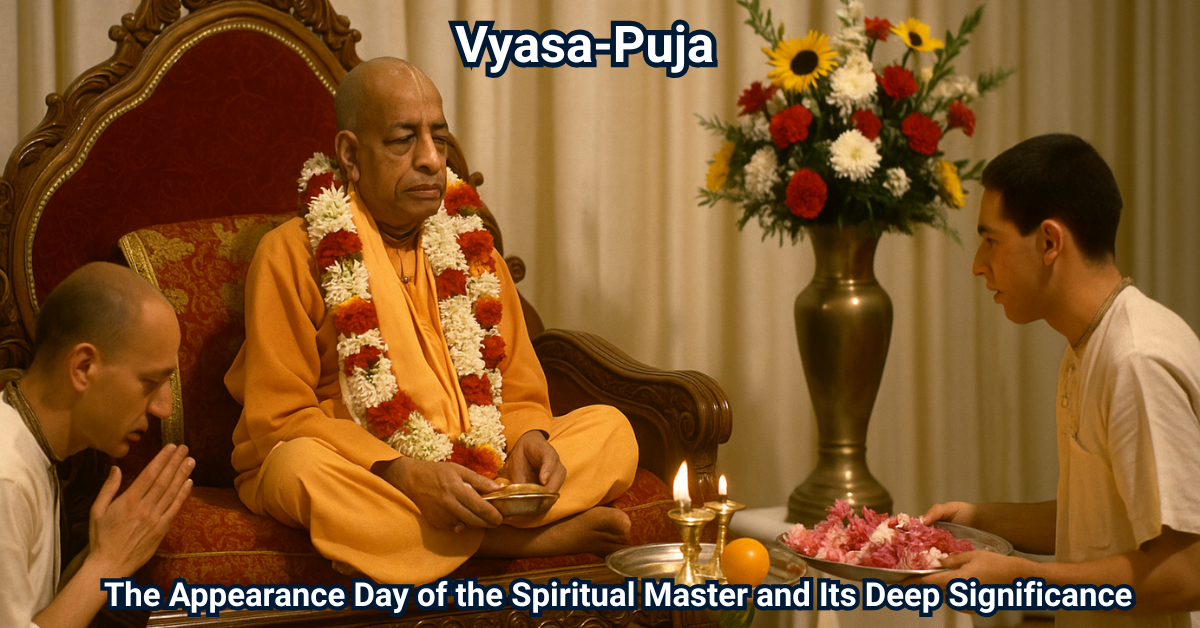Vyasa-Puja is the sacred appearance day of the spiritual master, deeply honoured in the Gaudiya Vaisnava tradition. Learn its purpose, rituals, history, significance, and how to observe it with devotion.
Vyasa-Puja: The Appearance Day of the Spiritual Master and Its Deep Significance
What Is Vyasa-Puja?
Vyasa-Puja (also spelled Vyasa-Puja) literally means “worship of Vyasa.” In the Gaudiya Vaisnava tradition, it is observed as the appearance day (birthday) of the spiritual master (acarya), who is considered a representative or incarnation of Veda Vyasa. The day is marked as a special festival when disciples offer their homage, devotional services, and gratitude to the spiritual master.
For ISKCON, Vyasa-Puja is the appearance day of Srila A. C. Bhaktivedanta Svami Prabhupada, the founder-acarya of their movement.
Because the spiritual master is seen as the present embodiment of the disciplic succession (parampara) from Veda Vyasa, homage offered to the guru is ultimately thought of as going upward through the line to the Supreme.
Quick Facts at a Glance
| Aspect | Details |
|---|---|
| Whose appearance | The acarya (guru) in the parampara — e.g., Srila Prabhupada for ISKCON |
| When | Annually, on the day corresponding to the guru’s birth in the lunar or solar calendar (for Prabhupāda, typically 27 August) |
| Main observances | Fasting, worship, offering homages, abhiṣheka, distribution of prasādam |
| Purpose | To express love and gratitude to the guru, recognise his role in the disciplic succession, and reinvigorate one’s spiritual commitment |
| Important texts | The compiled Vyasa-Puja book, containing homage offerings from disciples across the world |
Spiritual Significance of Vyasa-Puja
Guru as Embodiment of Vyasa
In the tradition, Lord Krishna imparted Vedic knowledge to Brahma, who passed it to Narada, then to Vyasa, and so on via disciplic succession. The spiritual master continues to transmit this knowledge without alteration. Thus, the guru is considered a living representative of Vyasa himself.
Therefore, paying homage to the guru on his appearance day is tantamount to offering respect to that disciplic heritage — one honors not just the person but the spiritual line he represents.
Reaffirming Devotional Service
Vyasa-Puja serves as an annual spiritual check-point: disciples review and recommit to their spiritual practices, re-establishing their connection to the guru’s teachings and mission. It is also a time of gratitude — recalling how the guru’s mercy has transformed the hearts of many.
Transcendence of Time
Though the guru’s physical body may no longer be present, in devotional vision his presence remains alive through his teachings, disciples, and the tradition. Thus, Vyasa-Puja is not a memorial but a living celebration.
How Vyasa-Puja Is Observed: Rituals, Practices, and Customs
The specific programme may vary among communities, but the following elements are common:
1. Fasting Till Noon
Many devotees observe a partial fast, refraining from food until midday, dedicating the early hours to spiritual practices.
2. Homage Offerings (Glorifications)
Devotees compose a heartfelt offering — in prose or verse — expressing their realization, gratitude, and aspirations under the guru’s shelter. These are collected globally and compiled into the annual Vyasa-Puja book.
Often the recipient acarya or institutional body reads these offerings publicly at the festival.
3. Abhiṣheka (Holy Bath Ceremony)
A special abhiṣheka (pouring of water, milk, yogurt, ghee, honey, etc.) is offered to the deity or picture of the guru as a mark of respect.
4. Kirtana, Chanting, Lectures
Devotional singing (kirtana), chanting of mantra, and talks explaining the guru’s teachings are integral parts of the observance. Some centers live-stream parts of the programme.
5. Release of Vyasa-Puja Book
At many ISKCON centres and in the worldwide movement, the yearly Vyasa-Puja book — containing the collected offerings — is officially released on this day.
6. Distribution of Prasadam
Sanctified food (prasadam) is distributed to all devotees and visitors toward the end of the festival.
7. Renewal of Service Commitments
Often devotees offer renewed service pledges — for preaching, book distribution, temple seva, etc. — and rededicate themselves to the guru’s mission.
Historical and Contemporary Context
- The practice of worshipping the spiritual master’s appearance day is well established in Gaudiya Vaiṣṇavism and among the followers of Caitanya Mahāprabhu.
- For ISKCON, Vyasa-Puja is one of the most celebrated festivals after Janmaṣṭamī.
- In recent decades the festival is celebrated globally — devotees from different countries submit offerings in writing, digitally, and with multimedia tributes.
- The Vyasa-Puja book is a major production each year, reflecting the depth and diversity of devotion across the movement.
Frequently Asked Questions (FAQs)
Q1: Must a disciple fast the whole day for Vyasa-Puja?
A: Not necessarily. Many observe a partial fast until noon, devoting morning hours to chanting, reading, worship. The observance should not become a burden but an expression of devotion.
Q2: Can one write a homage offering if not formally initiated?
A: Yes. Many devotees, friends, well-wishers, and even those not formally initiated submit offerings as a way to express gratitude for the guru’s teachings.
Q3: If the guru is no more physically present, how can we worship him?
A: The guru lives via his teachings, writings, disciples, and spiritual presence. Devotional remembrance, study, and service allow us to remain in his association.
Q4: What if my appearance day in the local lunar calendar differs from global date?
A: Some communities follow the local tithi, others follow the commonly recognized global date (e.g. 27 August for Srila Prabhupada). What matters is sincerity, not exact date.
Q5: What is the ideal mood when submitting a homage?
A: Always with humility, sincerity, introspection rather than boasting or flattery. The offering should show how one’s life is inspired by the guru’s mercy.







+ There are no comments
Add yours